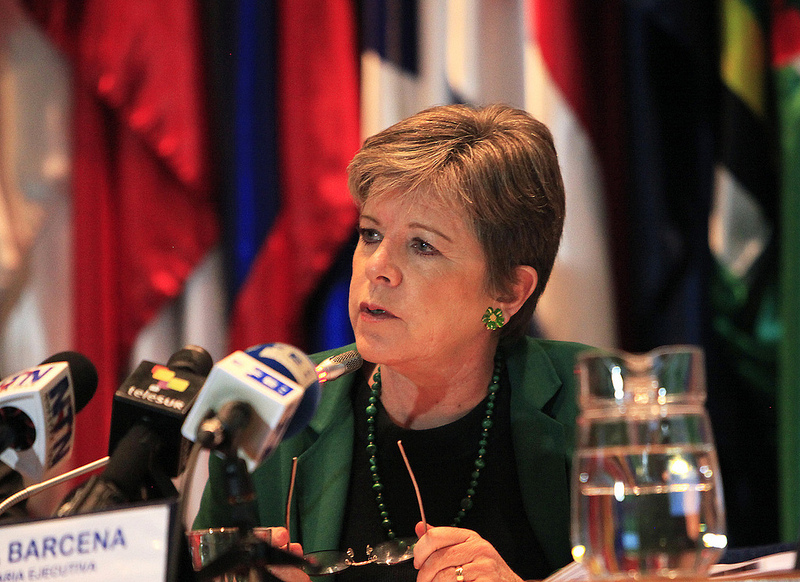Growth in Latin America and the Caribbean Will Reach 3.0% in 2013
Work area(s)
Topic(s)
Commission confirms the need for economies to diversify their production structure and increase productivity through greater investment.

See photo gallery
Watch video of the press conference.
(24 July 2013) As a whole, Latin American and Caribbean countries will grow by 3.0% in 2013, which is similar to last year's growth rate, according to a new ECLAC report launched at a press conference today in Santiago, Chile.
In the Economic Survey of Latin America and the Caribbean 2013, ECLAC states that the lower growth rate than the most recent estimate (3.5% in April) was partly due to slow growth in Brazil and Mexico. In addition, several countries that were growing quickly - such as Chile, Panama and Peru - experienced a slowdown in economic activity in recent months.
The report adds that the region has some weaknesses that could affect it in the short and long term, given the current negative external environment. Such weaknesses include the high dependency on exports to Europe and China, a growing current account deficit (reaching 2.0% of GDP in 2013, which is the highest level since 2001), major fiscal constraints in the Caribbean, Central America and Mexico, and South American vulnerability due to its dependence on natural resources.
Furthermore, economic growth remains largely dependent on consumption, which in 2013 has expanded less than in the previous year. Meanwhile, the contribution of investment to GDP will be modest, and net exports will make a negative contribution owing to the larger increase in imports than exports. Exports were down in the first half of 2013, and are probably facing the end of the boom period in commodity prices.
According to Alicia Bárcena, Executive Secretary of ECLAC, who presented the document, "the current situation highlights problems of growth sustainability in most of the region's economies, hence the need to broaden and diversify sources of growth. We also need a social covenant to increase investment and productivity, as well as changing production patterns to grow with equality".
The region's moderate economic performance is linked to estimated world economic growth of 2.3% (which is a similar rate to 2012). Owing to the ongoing recession in the euro zone during 2013, developing countries are expected to remain the drivers of world economic growth (although policies adopted by the United States and Japan are expected to boost these economies and promote greater worldwide economic growth in the coming year).
According to ECLAC estimates, Paraguay leads growth in 2013, with a 12.5% rise in GDP, followed by Panama (7.5%), Peru (5.9%), Bolivia (5.5%), Nicaragua (5.0%) and Chile (4.6%). Argentina is expected to grow by 3.5%, Brazil by 2.5% and Mexico by 2.8%.
Central America should grow by 4.0%, while South America is expected to grow by 3.1%. The Caribbean is expected to maintain the slow upward trend in growth observed in previous years (to reach 2.0%).
In the first six months of 2013, prices for many of the region's exports dropped, particularly minerals, metals, oil and some foodstuffs. This trend is associated with the euro zone recession and the slowdown of growth in China.
In 2013, export values are expected to rise by around 4.0%, which is higher than the 1.5% growth recorded in 2012 but much lower than the rates above 20% observed in 2011 and 2010. Imports are expected to grow by 6.0% in 2013 (compared with a rise of 4.3% in 2012).
As a result of the region's moderate economic growth, labour demand is not expected to rise significantly in 2013. Unemployment dipped from 6.9% to 6.7% in the first quarter of 2013, while 12-month cumulative regional inflation to May 2013 stood at 6.0% (compared with 5.5% in December 2012 and 5.8% in the 12 months to May 2012).
In the Economic Survey 2013, ECLAC analyses economic growth in recent decades and presents proposals to boost investment and productivity, with a view to achieving more stable and sustainable growth in the future.
While this period has seen profound economic transformations in Latin America and the Caribbean, levels of inequality and poverty remain high in many countries. Despite the positive terms of trade, capital accumulation has been insufficient and there have been limited gains in labour productivity.
According to the document, macroeconomic policies (and particularly fiscal, monetary and foreign exchange policies) could make a vital contribution to increased growth with equality in the future. This explains the need to strategically support macroeconomic policies for investment, so as to aid productive diversification in sectors that export or compete with imports (tradable-goods sectors).
The report highlights the need for robust institutions and social covenants to encourage investment, including short-term macroeconomic policies with a stabilizing and countercyclical effect, as well as long-term macroeconomic policies linked with industrial, social, labour and environmental policies - all with a view to promoting sustainable structural change and greater productivity.
Also see:
- Table. Latin America and the Caribbean. Total GDP, 2010-2013.
- Complete document: Economic Survey of Latin America and the Caribbean 2013.
- Presentation by ECLAC Executive Secretary, Alicia Bárcena.
For further questions, please contact ECLAC's Public Information and Web Services Section.
E-mail: prensa@cepal.org; Tel.: (56 2) 2210 2040.
Country(ies)
- Latin America and the Caribbean
Contact
Public Information Unit
- prensa@cepal.org
- (56 2) 2210 2040